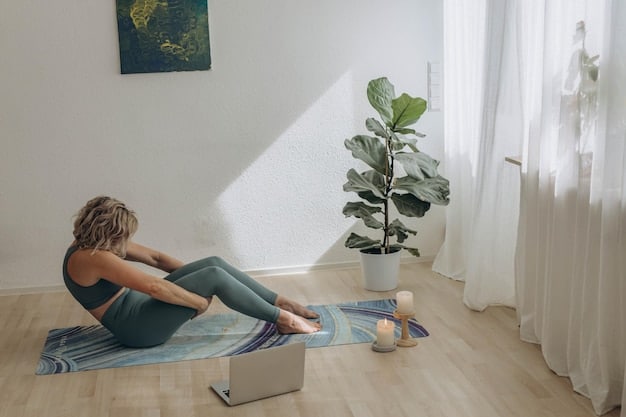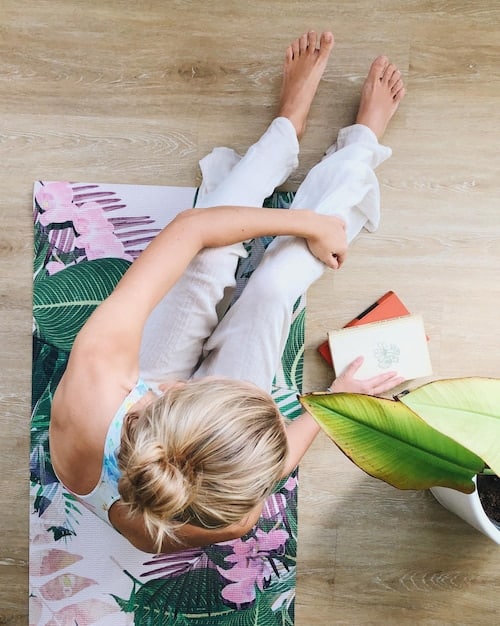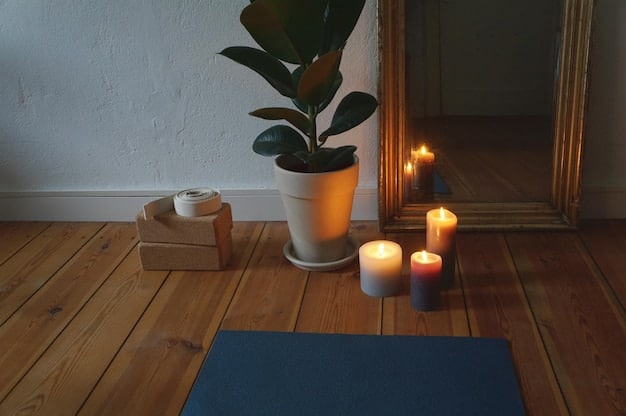Create Your Dream Home Yoga Studio on a Budget: Tips & Essentials

Creating a home yoga studio on a budget involves maximizing space, choosing affordable essential equipment, and setting the right ambiance to enhance your practice without breaking the bank.
Looking to deepen your yoga practice without the expensive studio fees? Discover how to create a home yoga studio on a budget: essential equipment and tips to transform any space into a tranquil sanctuary for your mind and body.
Setting the Intention: Defining Your Yoga Space
Before diving into equipment and decor, defining the purpose and vibe of your home yoga space is crucial. This initial step sets the intention for your practice and helps guide your budget-friendly decisions.
Consider the type of yoga you’ll primarily practice. Is it energetic Vinyasa, restorative Yin, or meditative Hatha? Your choice of style will influence the type of space and props you’ll need. Choose a room or area with enough space to move freely in all directions. Clear clutter to promote a sense of calm and focus.
Finding the Perfect Spot
Ideally, you’ll choose a room that’s naturally quiet and free from distractions. However, any space can be adapted with intention and creativity. If a dedicated room isn’t available, carve out a corner in your bedroom, living room, or even a covered patio.
Ambiance and Atmosphere
The ambiance of your yoga space plays a significant role in your practice. Natural light is ideal, but if your space is dimly lit, consider adding soft, warm lighting to create a relaxing atmosphere.
- Declutter: Remove any items that don’t contribute to a sense of calm or focus.
- Color Palette: Choose calming colors like blues, greens, or neutral tones for the walls or decor.
- Personal Touches: Add personal items that inspire you, such as crystals, artwork, or inspirational quotes.
With a clear intention and a well-defined space, you’re ready to start gathering the essential equipment for your budget-friendly home yoga studio. Remember, the key is to create a space that supports your practice and promotes a sense of well-being.
The Yoga Mat: Your Foundation
The yoga mat is arguably the most essential piece of equipment for any home yoga studio. It provides cushioning, grip, and a designated space for your practice. Fortunately, you don’t need to spend a fortune to find a quality mat.
When choosing a yoga mat, consider factors like thickness, material, and texture. A thicker mat offers more cushioning for your joints, while a textured surface provides better grip to prevent slipping.
Budget-Friendly Options
Many affordable yoga mats are available online and in sporting goods stores. Look for mats made from TPE (Thermoplastic Elastomer) or PVC (Polyvinyl Chloride). These materials are durable, easy to clean, and relatively inexpensive.
Mat Maintenance
Proper mat maintenance is crucial for hygiene and longevity. Clean your mat after each use with a simple solution of water and a few drops of mild soap. Avoid harsh chemicals or abrasive cleaners, which can damage the material.
- Regular Cleaning: Wipe down your mat after each practice to remove sweat and dirt.
- Deep Cleaning: Once a month, give your mat a more thorough cleaning with a diluted soap solution.
- Storage: Store your mat rolled up or lying flat in a cool, dry place to prevent damage.
With a quality yoga mat as your foundation, you’re well on your way to creating a budget-friendly home yoga studio that supports your practice and enhances your well-being. Remember to choose a mat that suits your needs and preferences, and take good care of it to ensure its longevity.

Essential Yoga Props on a Shoestring
Yoga props can enhance your practice by providing support, improving alignment, and deepening stretches. While some props can be expensive, many budget-friendly alternatives are available.
Consider which props would be most beneficial for your practice. Common props include yoga blocks, straps, blankets, and bolsters. Prioritize the props that will help you achieve better alignment and comfort in your favorite poses.
Creative Alternatives
Before purchasing new props, explore creative alternatives you may already have at home. Pillows can be used as bolsters, blankets can provide cushioning and support, and belts can serve as straps.
Yoga Blocks
Yoga blocks are essential for supporting proper alignment in various poses. They can help you reach the floor in poses like Triangle Pose or provide support in seated postures.
- DIY Blocks: Use sturdy books wrapped in towels or blankets as makeshift yoga blocks.
- Foam Blocks: Opt for affordable foam yoga blocks, which are lightweight and easy to grip.
- Wooden Blocks: If you prefer wooden blocks, look for secondhand options or wait for sales.
By utilizing creative alternatives and opting for affordable options, you can assemble a collection of essential yoga props without breaking the bank. Remember, the goal is to enhance your practice, not to accumulate expensive equipment.
Creating a Calming Atmosphere
The ambiance of your home yoga studio is just as important as the physical equipment. Creating a calming and inviting atmosphere can enhance your practice and promote a sense of well-being.
Consider incorporating elements that engage your senses and promote relaxation. Soft lighting, calming scents, and soothing music can all contribute to a more peaceful and enjoyable practice.
Lighting and Scents
Natural light is ideal, but if your space lacks natural light, use soft, warm lighting to create a cozy atmosphere. Scented candles, essential oil diffusers, or incense can add a calming aroma to your space.

Sound and Silence
Choose music that complements your practice and helps you relax. Nature sounds, ambient music, or instrumental pieces can all be effective. If you prefer silence, ensure your space is free from distractions and noise.
- Plants: Add greenery to your space with low-maintenance plants like succulents or snake plants.
- Artwork: Display calming artwork or inspirational quotes to inspire your practice.
- Textiles: Use soft blankets, cushions, and rugs to create a cozy and inviting atmosphere.
By paying attention to the details and incorporating elements that engage your senses, you can transform your home yoga studio into a tranquil and inviting space that supports your practice and promotes a sense of well-being.
Storage Solutions for Small Spaces
In small spaces, efficient storage is essential for keeping your yoga studio organized and clutter-free. Creative storage solutions can help you maximize space and keep your equipment easily accessible.
Assess your storage needs and identify areas where you can incorporate storage solutions. Consider using shelves, baskets, hooks, and rolling carts to keep your mats, props, and accessories organized.
Vertical Storage
Vertical storage is a great way to maximize space in small rooms. Shelves and wall-mounted racks can provide ample storage without taking up valuable floor space.
Rolling Carts
Rolling carts are versatile storage solutions that can be easily moved around your space. Use them to store yoga props, towels, and other accessories.
- Baskets: Use baskets to store smaller items like straps, socks, and essential oils.
- Hooks: Hang yoga mats and blankets on hooks to keep them off the floor.
- Multi-Purpose Furniture: Choose furniture with built-in storage, such as benches with storage compartments or ottomans with removable lids.
By implementing creative storage solutions, you can keep your home yoga studio organized and clutter-free, even in small spaces. A well-organized space promotes a sense of calm and allows you to focus on your practice.
Maintaining Your Home Yoga Sanctuary
Once you’ve created your budget-friendly home yoga studio, it’s essential to maintain it to ensure it remains a welcoming and inspiring space for your practice. Regular cleaning, organization, and mindful practices can help you maintain your sanctuary.
Establish a routine for cleaning and organizing your space. Wipe down your mat after each use, declutter regularly, and rearrange your props and accessories as needed. A clean and organized space promotes a sense of calm and focus.
Mindful Practices
Incorporate mindful practices into your routine to enhance your connection with your home yoga sanctuary. Light a candle, burn incense, or recite a mantra before each practice to set your intention and create a sacred space.
- Regular Cleaning: Wipe down your mat and props after each use.
- Decluttering: Regularly remove any items that don’t contribute to your practice.
- Reorganizing: Rearrange your space as needed to maintain a sense of freshness and inspiration.
By maintaining your home yoga sanctuary with regular cleaning, organization, and mindful practices, you can ensure it remains a welcoming and inspiring space for your practice for years to come.
| Key Element | Brief Description |
|---|---|
| 🧘 Yoga Mat | The foundation of your practice, providing cushion and grip. |
| 🧱 Yoga Blocks | Aid alignment and make poses more accessible. |
| 🕯️ Atmosphere | Lighting, scents, and sounds to enhance relaxation. |
| 📦 Storage | Keep your space tidy with shelves, baskets, and hooks. |
Frequently Asked Questions
▼
Ideally, you’ll want enough space to fully extend your arms and legs in all directions. A space of about 6ft x 8ft is generally sufficient for a single person.
▼
While you can, yoga mats are specifically designed to provide a non-slip surface, which is important for safety and stability in various poses.
▼
Sturdy books, firm pillows, or even rolled-up towels can serve as effective and cost-free alternatives to yoga blocks. Make sure they are stable and supportive.
▼
Lighting plays a crucial role in setting the ambiance. Soft, warm lighting is ideal for creating a relaxing atmosphere. Natural light is also beneficial if available.
▼
It’s best to wipe down your mat after each use to remove sweat and dirt. A deeper cleaning with a mild soap solution should be done at least once a month.
Conclusion
Creating a home yoga studio on a budget is entirely achievable with a bit of creativity and resourcefulness. By focusing on essential equipment, utilizing affordable alternatives, and creating a calming atmosphere, you can design a space that supports your practice and enhances your well-being without breaking the bank.





